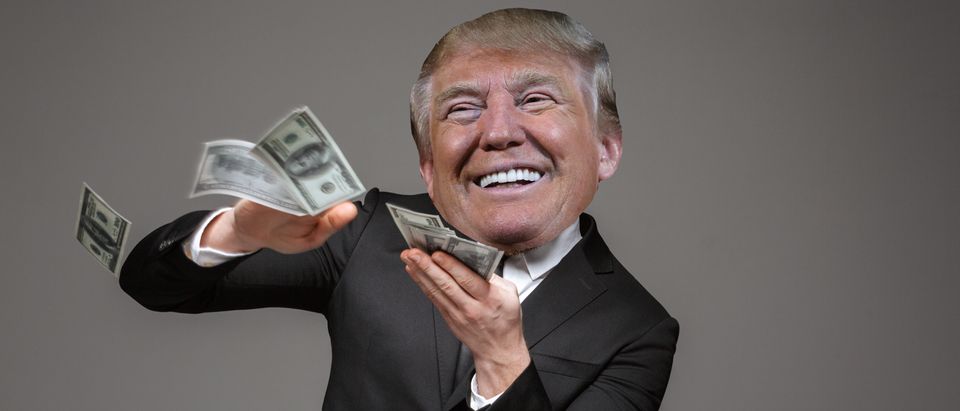For all the publicity Congress’s $1.3 trillion spending bill received back in March, President Trump signed another spending bill on Sept. 28 with surprising ease. While the budget is not a politically savvy talking point, this bill will have an immense impact on both parties’ bases.
Sept. 30 marked the end of the United States’ 2018 fiscal year — one in which the Federal Government added $445 billion to the budget deficit. And as Capitol Hill’s deficit hawks like Speaker Paul Ryan remain silent, the country appears doomed to plunge deeper into the red.
Interest payments will be one of the most significant pressures on our budget in the coming years. In a decade, the United States will spend $900 billion a year funding its past deficits, according to the Congressional Budget Office. For context, that exceeds what the government will pay for Medicaid and defense, two enormous expenditures.
The more the Federal Government spends, the more desperately it will need cash to pay its debts. As the United States becomes more desperate for cash, it will have to take from poor and middle-class taxpayers. Yet most Americans believe additional revenue should come from higher tax rates on high-income earners.
Some point to Scandinavian and other European countries, arguing their high, progressive taxes lead to better qualities of life. But what many of these proponents don’t realize is that these countries and progressive taxation aren’t so related.
Scandinavia has high tax rates, but those high rates apply to most of their population. For example, the standard for Denmark’s 60 percent marginal tax rate sits at just 1.2 times the national average. To put this in American terms, if this rate were applied here, all incomes over $60,000 would be taxed at 60 percent. Logically, this makes sense, as high government spending requires contributions from everyone.
Despite constant cries for change, the United States continues to have some of the most progressive taxes among developed nations––over five times more so than Scandinavia. So, there is really no weight to the idea of further shifting the tax burden to the high-earners. If anything, other developed countries demonstrate that if the U.S. wants to increase its revenues, it will have to rely on more contributions from all taxpayers.
Another way high-spending nations fund their budgets is through a value-added tax (VAT), a consumption tax paid at every stage of the production process. Because a VAT often applies to the same good several times before it reaches its end user, VATs are a significant boon to tax revenues.
To borrow an example, let’s say a knitting mill makes sweaters and buys $10 of yarn to make each sweater. The yarn-maker has officially given $10 in value to every sweater. If we use the EU’s average VAT rate of 21.7 percent, the yarn-maker must pay $2.17 in taxes for each set of yarn it sells the mill.
And the tax follows the sweater around as the process repeats itself — if the mill sells their sweaters to a warehouse, and the warehouse distributes to retailers, the 21.7 percent VAT is charged twice more.
Eventually, the sweater reaches the “end user,” who buys it. Unlike the manufacturers that can deduct from their end tax bill what their suppliers paid in taxes, consumers cannot deduct the VAT paid before them in the supply chain. The buyer will be the only party bearing the full brunt of the VAT.
A VAT is therefore effectively a regressive sales tax. Lower-income earners must devote more of their incomes to consumption, while higher-income earners can save and invest greater shares of their incomes. As a pattern, a person’s income is less subjected to a VAT as that person’s income rises, meaning VATs effectively tax low-income earners at higher rates than those with high incomes.
As much as Americans may wish to avoid burdening the poor and middle class with more taxes, something like a VAT may be the only feasible option to cut into the federal deficit. While a new tax on millionaires would raise additional revenue, it won’t raise revenues as much as its proponents think.
Even if the U.S. taxed the top 1 percent of income earners at 74 percent, there would still not be enough new revenue to cover the anticipated debt increase of $2.4 trillion — much less the deficit that existed before the GOP bill. The rest of America eventually will be called on to pay our debts.
Thus, fiscal responsibility is no longer for the sticklers — it is a matter of cauterizing a moral hazard. If we do not pay for our spending now, another generation will. And the further we pass it down, the more we will have to rely on the pockets of the poor and working class.
John Kristof is a Research Fellow at the Sagamore Institute and a contributor for Young Voices, writing frequently on fiscal and regulatory issues. Follow John on Twitter @jmkristof.
The views and opinions expressed in this commentary are those of the author and do not reflect the official position of The Daily Caller.


